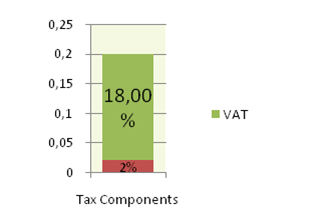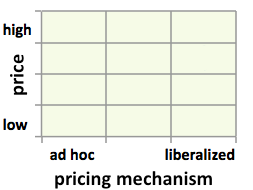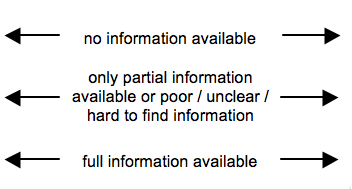Knowledge fuels change
For over a decade, Energypedia has shared free, reliable energy expertise with the world.
We’re now facing a serious funding gap.
Help keep this platform alive — your donation, big or small, truly matters!
Thank you for your support
Difference between revisions of "Fuel Prices Peru"
***** (***** | *****) m |
***** (***** | *****) |
||
| Line 1: | Line 1: | ||
{{Fuel Price Factsheet | {{Fuel Price Factsheet | ||
|Fuel Price Country=Peru | |Fuel Price Country=Peru | ||
| + | |Fuel Pricing Policies=Major fuel provider: petroperu: http://www.petrored.com.pe/pe_buscarEstaciones.aspx | ||
| + | |||
| + | '''Agencies:''' | ||
| + | |||
| + | “Ministry of Mines and Energy (MME): The Ministry does not have a control mechanism for verifying the increases or decreases in fuel prices. INEI publishes monthly the average end price to the public for oil products | ||
| + | |||
| + | National Institute of Statistics and Informatics (INEI): It publishes the variations in the average fuel price to the consumer in Metropolitan Lima. It also issues monthly reports for the domestic market on the structure of the full price for fuels.” | ||
| + | |||
| + | Source and further information: http://uneprisoe.org/Pricing/FuelPricingPolicies.pdf | ||
| + | |||
| + | "Prices were deregulated by a 2004 law but the Petroleum Product Stabilization Fund is used to smooth prices. The fund was established in May 2004 for an initial period of 120 days to tackle rising world oil prices at the time, and has continued to this day. The fund covers gasoline, diesel, LPG, and industrial oil for power generation. Government publishes reference fuel prices every week and adjusts prices within a price band, transferring money into or out of the stabilization fund. The fund’s debt in 2008 reached 3,000 million S/ (US$1 billion), which was retired in 2009. After a large budgetary transfer to the fund, another emergency decree was issued in April 2010, requiring the regulatory agency to adjust price bands every two months. The decree stated that the band for price variation was to be 5% except LPG, for which the band was to be 1.5%. " (Source: Kojima, Masami. (2013, forthcoming). “Petroleum product pricing and complementary policies:Experience of 65 developing countries since 2009.” Washington DC: World Bank.) | ||
|Fuel Currency=PEN | |Fuel Currency=PEN | ||
|Fuel Price Exchange Rate=2.76 | |Fuel Price Exchange Rate=2.76 | ||
| Line 10: | Line 21: | ||
|Fuel Price Composition Annotation=Source: http://facilito.osinerg.gob.pe/facilito/actions/PreciosCombustibleAutomotorAction.do | |Fuel Price Composition Annotation=Source: http://facilito.osinerg.gob.pe/facilito/actions/PreciosCombustibleAutomotorAction.do | ||
|Fuel Price Composition 2=GIZ_IFP2012_Peru2.png | |Fuel Price Composition 2=GIZ_IFP2012_Peru2.png | ||
| − | |||
| − | |||
| − | |||
| − | |||
| − | |||
| − | |||
| − | |||
| − | |||
| − | |||
|Fuel Matrix Pricing Mechanism=2 | |Fuel Matrix Pricing Mechanism=2 | ||
|Fuel Matrix Price Level=3 | |Fuel Matrix Price Level=3 | ||
Revision as of 15:46, 13 February 2013
Part of: GIZ International Fuel Price database
Also see: Peru Energy Situation
Fuel Pricing Policies
| Local Currency: | PEN |
| Exchange Rate: | 2.76
|
| Last Update: |
Major fuel provider: petroperu: http://www.petrored.com.pe/pe_buscarEstaciones.aspx
Agencies:
“Ministry of Mines and Energy (MME): The Ministry does not have a control mechanism for verifying the increases or decreases in fuel prices. INEI publishes monthly the average end price to the public for oil products
National Institute of Statistics and Informatics (INEI): It publishes the variations in the average fuel price to the consumer in Metropolitan Lima. It also issues monthly reports for the domestic market on the structure of the full price for fuels.”
Source and further information: http://uneprisoe.org/Pricing/FuelPricingPolicies.pdf
"Prices were deregulated by a 2004 law but the Petroleum Product Stabilization Fund is used to smooth prices. The fund was established in May 2004 for an initial period of 120 days to tackle rising world oil prices at the time, and has continued to this day. The fund covers gasoline, diesel, LPG, and industrial oil for power generation. Government publishes reference fuel prices every week and adjusts prices within a price band, transferring money into or out of the stabilization fund. The fund’s debt in 2008 reached 3,000 million S/ (US$1 billion), which was retired in 2009. After a large budgetary transfer to the fund, another emergency decree was issued in April 2010, requiring the regulatory agency to adjust price bands every two months. The decree stated that the band for price variation was to be 5% except LPG, for which the band was to be 1.5%. " (Source: Kojima, Masami. (2013, forthcoming). “Petroleum product pricing and complementary policies:Experience of 65 developing countries since 2009.” Washington DC: World Bank.)
Fuel Prices and Trends
| Gasoline 95 Octane | Diesel | |
|---|---|---|
| in USD* |
|
|
| in Local Currency |
|
|
* benchmark lines: green=US price; grey=price in Spain; red=price of Crude Oil
NOTE: in TIMELINE 2010: value per gallon → litre conversion: 14.77/3.79=45
Fuel Price Composition
Price composition for one litre of Gasoline 95 Octane as of 2010/11/01.


Source: http://facilito.osinerg.gob.pe/facilito/actions/PreciosCombustibleAutomotorAction.do
At a Glance
| Regulation-Price-Matrix |
| ||||
 |

|

|

| ||
Sources to the Public
| Type of Information | Web-Link / Source |
|---|---|
| Other Information | http://www.beip.gob.pe (Central Reserve Bank of Peru) |
| Other Information | http://www.mem.gob.pe (Ministry of Energy and Mines) |
| Other Information | http://www.petroperu.com (Petroleos del Peru) |
| Pump prices and margins | http://www.petrored.com.pe/pe_buscarEstaciones.aspx |
| Pump prices and margins | http://facilito.osinerg.gob.pe/facilito/pages/facilito/buscadorEESS.jsp |
Contact
Please find more information on GIZ International Fuel Price Database and http://www.giz.de/fuelprices
The following coordinate was not recognized: {{#geocode: Peru|google }}.



















